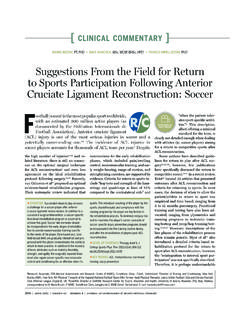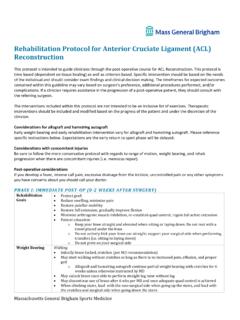Transcription of Melbourne ACL Rehab 2018 2
1 AC. Melbourne ACL Rehabilitation Guide A criteria driven ACL rehabilitation protocol and guide for both clinicians and people who have undergone a surgical reconstruction of the Anterior Cruciate Ligament (ACL). Proudly supported by: Authors: Randall Cooper & Mick Hughes Table of Contents p3. About the Authors p4. Introduction p5. Pre-op Injury recovery & Readiness Phase: for surgery p7. Phase 1: recovery from surgery p9. Phase 2: Strength and Neuromuscular Control p13. Phase 3: Running, Agility and Landings p17. Phase 4: Return to Sport p28. Phase 5: Prevention of Re-injury p29. Bibliography Proudly supported by: 2. About Authors Randall Cooper Mick Hughes Randall Cooper is an experienced Sports Mick is an experienced Physiotherapist &. Physiotherapist who consults at the Olympic Exercise Physiologist who consults at The Park Sports Medicine Centre in Melbourne , Melbourne Sports Medicine Centre. and is a fellow of the Australian College of Physiotherapists.
2 Randall is a former Olympic Mick has expertise in ACL injury management and AFL (Hawthorn FC) physiotherapist, but and ACL injury prevention and has previously works with people of all abilities. He has worked for elite sporting teams such as the published studies in international sports Collingwood Magpies Netball team, medicine journals, contributed to leading Newcastle Jets U20s Soccer team and NQ. texts, and presented on many sports Cowboys U20s Rugby League team. medicine related topics at major conferences and in the media. Randall is the founder and Mick Hughes , Sci., Grad Cert Sports Physio director of sports skincare company Premax. Randall Cooper , M. Physio, FACP. Sports Physiotherapist Proudly supported by: 3. ACL. Introduction Rehabilitation ACL Rehab : Melbourne ACL. Protocol Rehabilitation Guide The ACL rehabilitation protocol featured in this eBook is a guide for both clinicians and people who have undergone a surgical Goal Based reconstruction of the Anterior Cruciate Ligament (ACL).
3 You move through the ACL protocol at your own pace, and let the criteria govern how quickly you go, not a pre-determined timeline. Pre Injury recovery PHASE: & readiness for Here are a few tips on how to progress through an ACL Rehab protocol with minimal problems: Op surgery Get the knee straight early (within the first 2-3 weeks both post injury and post surgery ), and keep it straight. Flexion can progress gradually. Use knee pain and knee swelling as a guide. If either or both 1. are increasing, the knee isn't tolerating what you're doing to it. recovery PHASE: Technique is everything. Compensation patterns develop after from an ACL tear, so focusing on correct muscle and surgery movement/biomechanical patterns is paramount. Build high impact forces gradually. The articular structures in the knee joint will take time to adapt to a resumption of running, jumping and landing. Complete your ACL rehabilitation. Once people are back running with no knee pain it's easy to think that it's all done.
4 But the last 1/3 of the protocol is the most important to help reduce the chance of re-injury, increase the chance of a successful return to sport, and possibly to reduce the likelihood of osteoarthritis down the track. PHASE: 2 Strength and neuromuscular control As much as possible outcome measures that are evidence based have been used, and only tests that can be performed with simple and inexpensive equipment have been included. 3 Running, PHASE: Clinicians should use a clinical reasoning approach in agility and prescribing an exercise rehabilitation program and landings management advice for each phase. This ACL protocol briefly suggests typical exercises for each phase, but programs should always be individualised. The ACL Rehab protocol is broken down into 6 phases, and there's a list of goals and outcome measures that need to be 4. satisfied at the end of each phase to move onto the next one. Return PHASE: to sport The six phases are: Pre-op Phase: Injury recovery & readiness for surgery Phase 1: recovery from surgery Phase 2: Strength & neuromuscular control 5 Prevent PHASE: Phase 3: Running, agility, and landings re-injury Phase 4: Return to sport Phase 5: Prevention of re-injury Proudly supported by: 4.
5 Injury recovery Pre-op Phase: & Readiness for surgery Whilst people may want to have the operation as soon as possible, it's important to allow the knee to settle from the injury Pre-op Phase and regain a good level of strength and function before surgery . Injury recovery & readiness for Recent research has suggested that people who attain full range surgery of motion, good quadriceps and hamstring strength, and minimal swelling prior to surgery have better outcomes than those who don't up to 2 years post surgery . Most important goals Exercises and activities during this phase typically include regular icing of the knee to reduce swelling, range of motion exercises, low impact aerobic exercise such as cycling, and a progressive strengthening regime. Eliminate swelling Strength exercises should progress in parallel with the clinical condition of the knee. As the pain & swelling settles, and the range of motion increases, strength exercise can progress to include weighted exercises in the gym and jump and land activities such as hopping drills.
6 Aggressive change of direction activities should be avoided during this phase. This pre- surgery phase also allows clinicians to gather information that can be used to determine readiness to return Regain full range to training and sport. of motion The three most important goals of the Pre-op Phase are;. Eliminate swelling Regain full range of motion Regain 90% strength in the quads and hamstring compared with the other side Regain 90% strength in the quads and hamstring compared with the other side Proudly supported by: 5. Injury recovery Pre-op Phase: & Readiness for surgery Pre-op: Outcome Measures and Goals Outcome Measure Test Description & Reference Goal . Passive Supine with a long arm goniometer (Norkin & White, 1995). 0 . Knee Extension Bony landmarks: greater trochanter, the lateral femoral condyle, and the lateral mallelous. Passive Supine with a long arm goniometer (Norkin & White, 1995). 125+. Knee Flexion Bony landmarks: greater trochanter, the lateral femoral condyle, and the lateral mallelous.
7 Swelling/ Stroke Test (Sturgill et al, 2009) Zero Effusion Zero: No wave produced on downstroke 1+. Trace: Small wave on medial side with downstroke 1+: Large bulge on medial side with downstroke 2+: Effusion spontaneously returns to medial side after upstroke 3+: So much uid that it is not possible to move the effusion out of the medial aspect of the knee Strength Hand held dynamometer testing (Mentiplay et al, 2015) 90%. Quads: Participant seated and hip and knees exed at 90 . compared Dynamometer placed on the anterior aspect of the shank, with proximal to the ankle joint. other Hamstrings: Participant seated and hips and knees exed at side 90 . Dynamometer placed on the posterior aspect of the shank, proximal to the ankle joint. Single Hop Test Single leg hop test (Reid et al, 2007) 90%. Subjects stand on one leg and hop as far forward as possible compared and land on the same leg. The distance is recorded from toe with at take-off to heel at landing with a tape measure which is other xed to the ground.
8 Side Two valid hops are performed, with the average (mean) of the 2 being used for calculation. A limb symmetry index is calculated by dividing the mean distance (cms) of the involved limb by the mean distance of the non involved limb then multiplying by 100. Proudly supported by: 6. recovery Phase 1. from surgery acl reconstruction surgery is traumatic to the knee and a period of rest and recovery is required after the operation. Whilst it's tempting to want to get going and improve strength and range of motion, it's best to let the knee settle for the first 1-2 weeks with basic range exercises, quadriceps setting Phase 1. drills, ice and compression. recovery from surgery Typical exercises and management activities during this phase include regular icing of the knee and graft donor site (usually either the hamstrings, quad or patella tendon), compression of the knee and lower limb, basic quadriceps Most important goals setting exercises, and gentle range of motion exercises to improve knee extension (straightening) and flexion (bending).
9 Analgesics and other medications should only be used in consultation with your doctor. Get knee straight The three most important goals of Phase 1 are: Get the knee straight (full extension). Settle the swelling down to mild'. Get the quadriceps ring again Settle the swelling Get quadriceps firing Proudly supported by: 7. recovery Phase 1. from surgery Phase 1: Outcome Measures and Goals Outcome Measure Test Description & Reference Goal . Passive Supine with a long arm goniometer (Norkin & White, 1995). 0 . Knee Extension Bony landmarks: greater trochanter, the lateral femoral condyle, and the lateral mallelous. Passive Supine with a long arm goniometer (Norkin & White, 1995). 125+. Knee Flexion Bony landmarks: greater trochanter, the lateral femoral condyle, and the lateral mallelous. Swelling/ Stroke Test (Sturgill et al, 2009) Zero Effusion Zero: No wave produced on downstroke 1+. Trace: Small wave on medial side with downstroke 1+: Large bulge on medial side with downstroke 2+: Effusion spontaneously returns to medial side after upstroke 3+: So much uid that it is not possible to move the effusion out of the medial aspect of the knee Strength Quadriceps lag test *variation (Stillman, 2004) 0 to 5.
10 With the patient sitting on the edge of a treatment bed, the lag therapist takes the relaxed knee into full passive extension. The patient is then required to maintain full active extension of the knee when the therapist removes support. Proudly supported by: 8. Strength and Phase 2. Neuromuscular Control Regaining muscle strength, balance, and basic co-ordination are the goals of Phase 2. This phase usually commences with Phase 2. easy body weight type exercises and progresses into a Strength and gym-based regime with a mixture of resistance, balance, and co-ordination exercises. neuromuscular control It's important for clinicians and patients to listen to the knee'. during this phase and only progress as quickly as the knee Most important goals will allow. Increase in pain and/or swelling are the two main symptoms that indicate that the knee is not tolerating the workload. Typical exercises and management activities during this phase include lunges, step-ups, squats, bridging, calf raises, Regain single leg hip abduction strengthening, core exercises, balance, gait balance re-education drills, and non-impact aerobic condition such as cycling, swimming, and walking.


